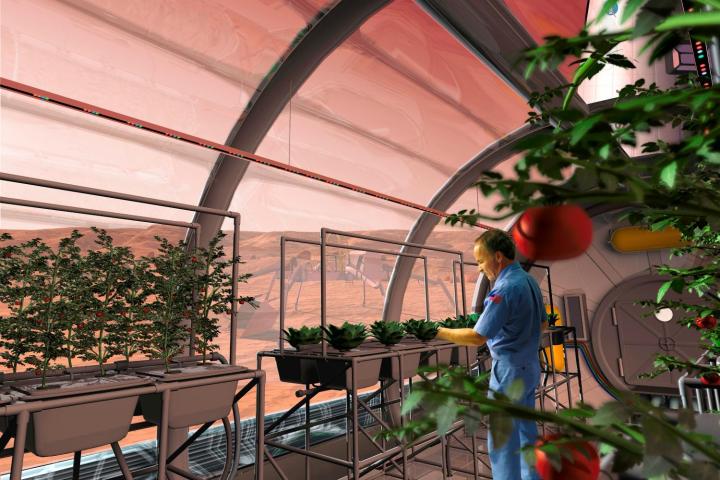

NASA plans to send humans to Mars in the 2030s, and it’s Larry Toups’ job to make the planet habitable once they get there. To do so, he looks to not-quite-alien environments like submarines, Antarctic research stations, and oil rigs. He also builds upon what he learned as part of the team constructing the International Space Station. The habitable satellite is a proving ground for future Mars technology, too.
As part of a team made up of fewer than 20 people, Toups is Habitation Lead for NASA’s Human Space Flight Architecture Team, working on the Evolvable Mars Campaign. “The real important work, at least for the next five to ten years, is how do we evolve from our space station, which we have in the lower earth orbit, and how do we enable exploring, going further out into the solar system and for longer periods of time,” he tells Digital Trends. “The ultimate destination with this work is Mars.” NASA, as well as some other groups like Mars One, want to establish a foothold on the Red Planet, to “pioneer it,” as Toups says.
While Toups’ background is in architecture — he has a Masters Degree in Space Architecture from the University of Houston’s Sasakawa Institute for Space Architecture — other project members are focused on food production, life-support systems, or power systems. Creating a habitat on Mars does have some similarities to building a house on earth, he says. “It’s the integration of many different disciplines that all have different expertise that, if you organize it right and everyone works as a team, you come out with a very cohesive, integrated set of solutions to some very far-out problems.”
And making Mars livable isn’t as simple as finding a heater to make the minus-80-degrees-Fahrenheit average temperatures bearable. Getting there is half the battle, as everything needs to fit in the rockets taking the months-long journey. This includes the habitat itself, hence why the structure is inflatable: Travel light and carry an expandable building.

Just because it’s inflatable doesn’t mean it won’t be protective; it will have to be, to allow humans to survive. “On the surface of Mars, you don’t have the benefit of our atmosphere on Earth, which shields a lot of the galactic, cosmic radiation, as well as shelters you from solar flare events,” says Toups.
Because the trip back and forth is a long one (and one whose length depends on where the two planets are in their orbits), those heading to Mars will need to fend for themselves when it comes to food, water, and oxygen. “It will probably be, in my estimation, the most sustainable home that you’ll ever build,” Toups says, “because you’ll be in an environment where there is no existing, pre-integrated electrical grid.” The Mars dwellers will have to recycle as much waste water as possible. “Currently on Space Station, we have a system in place that recycles a certain percentage of the waste water, if you want to call it that: condensate, perspiration from the crew, urine, all those types of things that come into play,” says Toups. “I think our recovery rate is hovering around 90 percent.” As for food, crew members on ISS are starting to grow some small, leafy plants, though on Mars these could pull double duty converting carbon dioxide. The habitat could be put in place before the crew arrives, which is why the Evolvable team is looking at autonomous technology like smart thermostats, in case the structure needs to take care of itself.
Other areas of the habitat could include a sort of lab for experiments, a common area for the crew to eat meals together, spaces for medical and repair equipment, and a place to watch training videos to keep their skills sharp. While Toups admits the structure will be Spartan, he says it’s important to also design for the psychological aspects of the mission. The crew may be away from home for three years. In order to make the habitat feel like home, Toups and the team think about things like normalizing the pressure to feel like Earth but also providing entertainment and potentially a way to connect with those they left behind.
Toups compares it to the way people become acclimatized to the chilly, air-conditioned feel of their office buildings on hot summer days. For the temporary Martians, the harsh outdoor conditions will always be foreign and walled off; what’s inside becomes the natural environment. “The characteristic of a Mars habitat might take on, at least initially, the sense of a very safe haven that you find comforting,” says Toups. “Whatever you’re providing for that internal atmosphere is safe and secure; you don’t want to have a breach of that. That’s, as they say, a bad day at the office.”
Editors' Recommendations
- The sound of science: Why audio is the next frontier in Mars exploration
- NASA is operating its Mars Curiosity rover from workers’ home offices
- Mars Helicopter attached to Perseverance Rover ahead of launch
- NASA’s Mars helicopter spins blades for last time before launch
- 11 million names to be carried to Mars on NASA’s Perseverance rover


